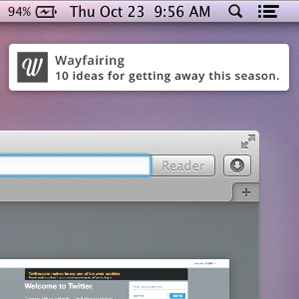Alert! Websites Will Soon Start Pushing App-Style Notifications
What some call the smartphone era might better be termed the notification era.

The pop-up windows that inform you of a new message or tweet have become a central part of using mobile devices. And wearable devices such as Google Glass and the Apple Watch have been designed largely as conduits for notifications. Now, ordinary websites are going to send them to you too.
In 2015, most leading Web browsers will be set to support what are known as push notifications. Sites using the technology will be able to ask visitors if they wish to opt in to receive notifications. The site can then deliver them, even if that site is not open in the browser at the time. A news site might use Web notifications to alert users to a breaking story, for example. The technology should become available on both PCs and mobile devices.
The notifications appear in small pop-up windows, like the ones an e-mail program might use to alert you about new messages.
A small number of websites, including those of the New York Times and the NBA, already issue notifications to users of Apple computers. Apple rolled out its version of the technology in an update to its OS X desktop operating system last year.
But sites offering Web notifications could soon become much more widespread. Google and Mozilla are working to add the technology to their Chrome and Firefox browsers, which would make the feature available to the majority of people browsing the Web from a PC.
When that happens, Web pages will be able to behave much like mobile apps, says Michael van Ouwerkerk, a software engineer on Google’s Chrome team who’s working on the technology. “Once the user has opted in, Web apps will be able to provide timely information to the user without having to go through an installation process,” he says. For example, when you check your flight status on an airline’s mobile website, a single tap could subscribe you to updates on any delays.

Google won’t comment on when Web notifications will be released, and Mozilla didn’t respond to a question about its own expected release of the technology. Tim Varner, cofounder of a startup called Roost, which offers tools to help website publishers use Web push notifications, says he expects both companies to release the technology for their mobile and desktop browsers within a few months.
Roost’s customers include the St. Louis Post-Dispatch and the tech news site The Next Web. Both media companies use push notifications to inform readers of fresh stories.
Varner predicts the technology will be particularly popular for mobile sites. Without notifications, he says, mobile Web pages are not so good for engaging users. “In theory the app store could lose a little bit of its hold on the market,” he says, observing that Web notifications could let Web pages offer a much richer experience. Another reason companies may adopt the technology is that it may prove easier to catch people’s attention in a channel that’s not already deluging people with messages, as e-mail and mobile app notifications do.
The idea of providing a dedicated medium for people to subscribe to alerts and content from websites is not new. In the late 2000s many websites began pushing out content in a format called RSS, and many people used RSS readers to curate collections of feeds. As social networks such as Facebook and Twitter rose in popularity, the popularity of RSS waned. Last year Google killed its RSS reader, the most widely used, saying its “usage has declined.”
Dave Winer, who helped create RSS, remains skeptical that Web notifications will take off in a similar way. He points out that there is no agreed standard, and that Apple, Mozilla, and Google are all pursuing different approaches.
That could make it complicated for publishers to push notifications to people using different browsers or operating systems. The Web standards body the W3C has a group working on a standard, but it is not complete. “Unless something comes out of left field and is adopted by developers—and isn’t owned by a company seeking lock-in—I think RSS is what we have, for now,” says Winer.
Keep Reading
Most Popular
Large language models can do jaw-dropping things. But nobody knows exactly why.
And that's a problem. Figuring it out is one of the biggest scientific puzzles of our time and a crucial step towards controlling more powerful future models.
How scientists traced a mysterious covid case back to six toilets
When wastewater surveillance turns into a hunt for a single infected individual, the ethics get tricky.
The problem with plug-in hybrids? Their drivers.
Plug-in hybrids are often sold as a transition to EVs, but new data from Europe shows we’re still underestimating the emissions they produce.
Stay connected
Get the latest updates from
MIT Technology Review
Discover special offers, top stories, upcoming events, and more.